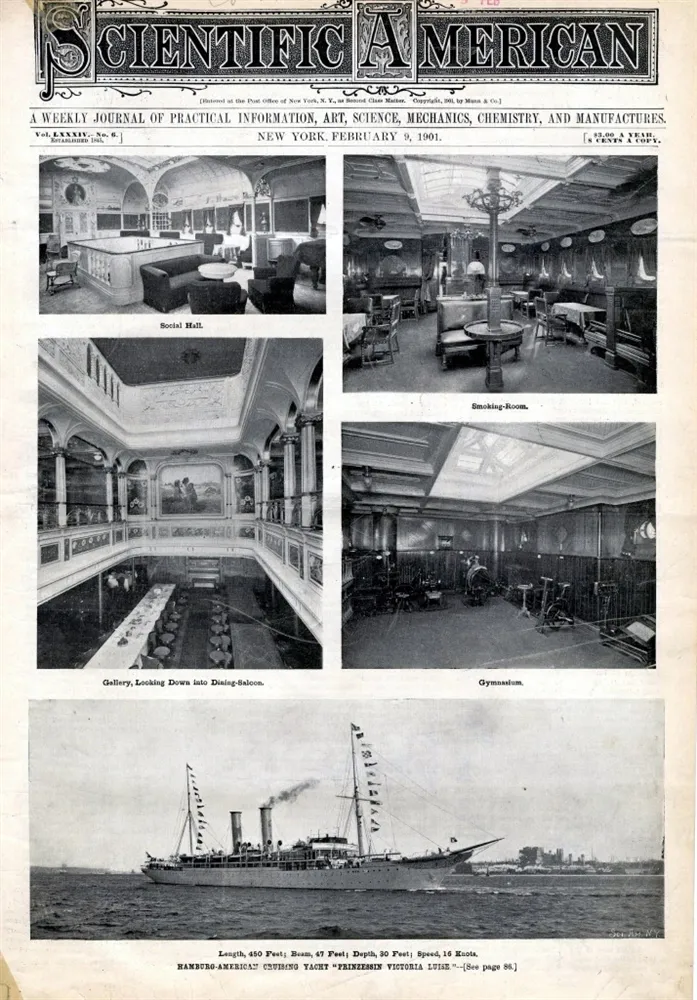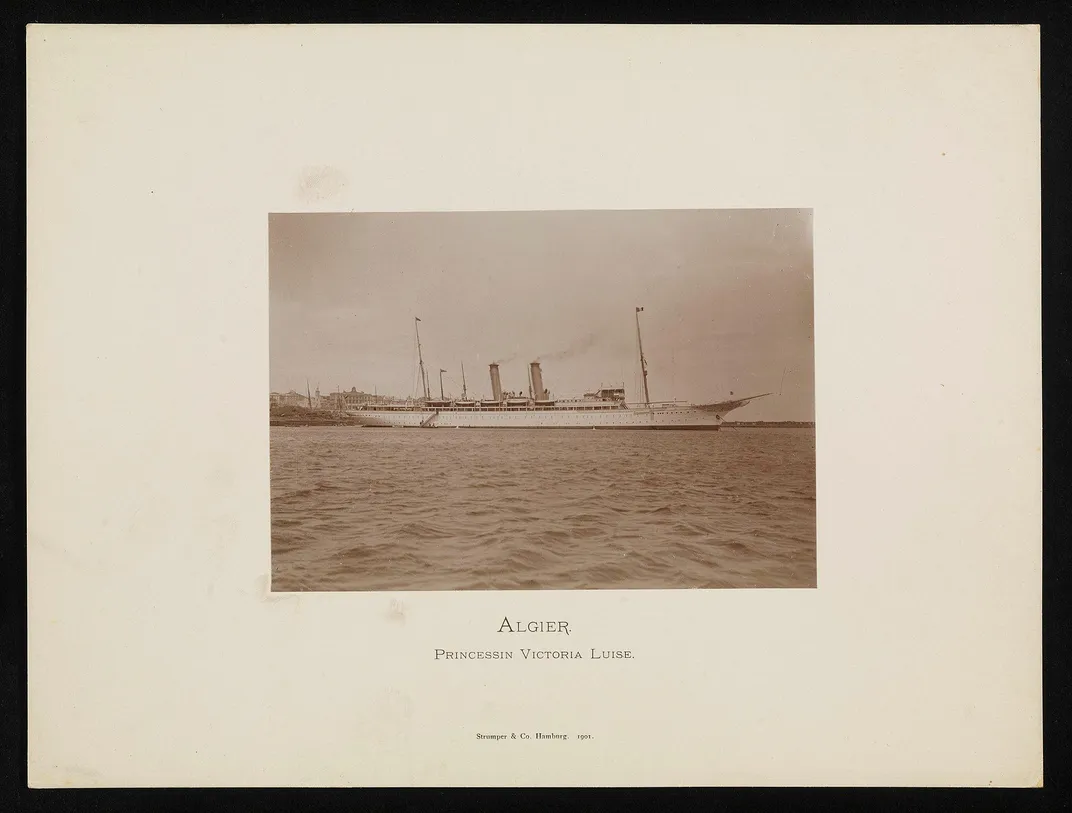Where Did the World's First Cruise Line Depart From?
/https://tf-cmsv2-smithsonianmag-media.s3.amazonaws.com/filer/73/5d/735d5825-be84-45cc-aea6-23ddfba8d081/1920px-prinzessin_victoria_luise_loc_det4a15439.jpg)
Shipping magnate Albert Ballin had a vision. He saw a future of leisurely sea travel available to anyone willing to pay the price of a ticket. The late-19th century director of the Hamburg-Amerikanische Packetfahrt-Actien-Gesellschaft (HAPAG), or Hamburg-America Line, knew the future of the company rested beyond shipping cargo across the Atlantic.
The Jewish son of a Danish immigrant took over his father's immigration agency in 1874. But he became part of Germany's elite (an odd fit because corrosive attitudes towards Jews were already taking shape) when he transformed the family business into an independent shipping line, earning the attention of HAPAG executives who hired him in 1886 and made him their general director in 1899.
One of his first orders of business after assuming the leadership role was to commission the first purpose-built cruise ship the world had ever known: the Prinzessin Victoria Luise.
"The Hamburg-America Line was the world's largest shipping firm at the time," says Peter McCracken, a librarian at Cornell University and publisher of the vessel-research database ShipIndex.org. "As its general director, Ballin was responsible for maintaining that position and for moving the company forward."
Over the previous decade, Ballin oversaw the expansion of the passenger arm of the company by retrofitting freight ships into barely acceptable cruise liners to some success. Though some HAPAG executives initially balked at the idea ("Germans will travel out of necessity, but they would surely not submit themselves to the hazards and discomforts of a long voyage just for the incidental fun of it," one colleague told him,) Ballin proceeded anyway.
He began in January 1891 by repurposing the Augusta Victoria, one of the ocean liners in the company's fleet, into a leisurely cruising vessel for wealthy tourists. What's more, he knew he needed to offset losses during the winter months, when fewer freight orders came through and frozen waterways made sea travel dangerous. Daniel Finamore, associate director of exhibitions at the Peabody Essex Museum in Salem, Massachusetts, says that Ballin understood the company needed "to maximize use of their large ships" by "organizing pleasure cruises to Caribbean ports and warmer climates during winter."
Ballin soon realized, however, that the Augusta Victoria had significant limitations when it came to pleasure exclusions at sea. Passengers had to tolerate unsightly machinery, restrictive deck space, and a lack of onboard amenities. The ship itself was too large to navigate into the smaller ports near popular tourist destinations. And the austere sleeping accommodations were undesirable for high-minded first-class passengers, too, all of which made the Augusta Victoria a temporary measure. Scientific American reported at the time that "the venture was looked upon...as somewhat of an experiment."

His innovation was recognizing the appeal of luxury sea travel designed specifically for the experience of the journey.
By 1899, Ballin hired the shipbuilder Blohm & Voss to construct a vessel specifically outfitted for what he had in mind. In the Prinzessin Victoria Luise, he had a 407-foot, 4,419-ton vessel with twin-screw engines that could cut through the water at a speed of 16 knots. (About 19 miles per hour; the Titantic's top speed was 23 knots.) In 1971's The Sway of the Grand Saloon: A Social History of the North Atlantic, author and historian John Malcolm Brinnin described the ship as having "the white hull of a yacht, a long clipper stem and bowsprit, buff-colored funnels."
In February 1901, Scientific American highlighted that the vessel was "designed for a class of service which hitherto has been performed by the regular ships of this company...the first vessel of her kind to be built purely for yachting [leisure cruising] purposes."
Brinnin gives Ballin full credit for the accomplishment: "The real breakthrough in pleasure cruising, at least as the 20th century would come to know it, was...the single-handed gesture of Albert Ballin," he wrote in Grand Saloon.
Indeed, James Delgado, the former director of NOAA's Maritime Heritage Program, and senior vice president of SEARCH, a marine archaeology program, acknowledged Ballin's contributions as well and says there is consensus that the Prinzessin Victoria Luise was the "first purpose-built, non-private excursion ship: what we call 'cruise' ships today."
Named by Ballin after the German emperor's only daughter, the Victoria Luise boasted a large gymnasium, a social hall, a library, a smoking room, a palatial art gallery surrounding the dining room, spacious promenade decks, a ballroom for dancing, a darkroom for amateur photographers and 120 unusually commodious first-class only staterooms—each equipped with elegant European furnishings, brass beds and double-light portholes that were opened when the ship was in warm climates. "It was Ballin's intention that the style and service (on board) should be commensurate with the finest European hotels," says Bruce Peter, a design historian at the Glasgow School of Art in Scotland and author of Cruise Ships: A Design Voyage.
"There was no consideration for accommodating lesser fare passengers or freight," Delgado explains, "just cruising in style in well-appointed cabins with good food and visiting different ports."
After launching from Hamburg on June 29, 1900, the Victoria Luise's first cruise lasted 35 days and explored ports in the West Indies and Venezuela. Subsequent Victoria Luise cruises sometimes followed the same route, at times changing destinations across the Mediterranean and Baltic Seas and beyond. "The vessel sailed to Norway and the Baltic in summer, to the Mediterranean and to the Caribbean in winter," Peter says, noting "the four ever-popular cruising regions." Over the years it docked in ports in New York, France, England, Ireland, Scotland, the North Cape in Norway and St Petersburg.
"Every port had well-planned shore excursions," says Finamore.
Even though the superrich already had yachts of their own "none were available for public bookings," Finamore explains—and Ballin knew he'd need to market to a wealthy clientele in order to make the venture a success. To that end, he requested that engineering journals refer to the Victoria Luise as a "cruising yacht."
The Victoria Luise made leisure cruising available to people who couldn't afford "the upkeep and maintenance, let alone the expense of building such vessels," Delgado says. Adds Peter, "There was a strong desire among the very wealthy to emulate the style of royals and emperors." Its popularity opened the doors to many additional such vessels being commissioned by HAPAG officials; with other popular shipping lines of the day following suit. (Including the White Star Line, the navigation company responsible for commissioning the Titanic.)
The deck of the Victoria Luise boasted a permanent awning framework that provided shade and shelter while nearby musicians entertained guests. Inside, "a string quartet would play from the dining saloon balcony at dinner," Peter says, and "local performers would be brought onboard to give the passengers a taste of the exotic when in specific ports."
In addition to entertainment, passengers expected decadent cuisine on board and enjoyed it in abundance, though not without great effort. "Fine-dining on a ship such as this was a particular challenge," Finamore says. "Everything on a broad menu offering multiple courses had to be planned, stored, preserved and prepared on board." Menu selections aboard one Victoria Luise cruise included beef broth with farina dumplings and roast duck and whortleberry soup. To celebrate Abraham Lincoln's birthday at sea on February 12, 1906—either as a nod to the ship's American passengers or just an excuse to throw a party, or both—the chef offered selections of fried halibut in Russian sauce, or Strasbourg goose in jelly, while the ship's band played John Philip Sousa's "The Stars and Stripes Forever" from the surrounding balcony.

Fine-dining and lively entertainment were no substitute for good seamanship, however, and the majesty and tranquility of the Prinzessin Victoria Luise was short-lived. While on a Caribbean cruise in December 1906, it crashed against an uncharted ridge off the coast of Jamaica. Captain H. Brunswig had had tried to enter the harbor without aid and had incorrectly identified the Plumb Point Lighthouse for the lighthouse at the port he was due at, the Port Royal Lighthouse. To make matters worse, Peter says, "the shape of the seabed off Jamaica had been changed by a recent volcanic eruption, so the charts the captain depended on were wrong."
Though no passengers were harmed when the ship ran aground (everyone was rescued by the following morning), Brunswig retreated to his cabin after the evacuation and ended his life with a pistol. "I cannot account for his act except on the theory that his pride was crushed by the accident, and that he believed that only death would wipe out what he regarded as his disgrace," an HAPAG executive said at the time. A New York Times article of a few days later said the captain had been "one of the best known and most reliable commanders in the company's service." His death came as a shock to colleagues. "Though he was clearly to blame," McCracken says, "his steward and other officers later said that they certainly did not expect him to commit suicide."
The ship itself tragically shared its captain's fate. After pounding waves were seen "breaking over her pitilessly," as a Jamaican news article said at the time, the vessel quickly became a total loss and was soon "abandoned and left to her fate." As Brinnin wrote in Grand Saloon: "The sea had claimed one of its prettiest prizes." Upon hearing of the loss of his ship, Ballin commissioned a replacement vessel to be built by the same shipbuilder, which he named The Meteor.
After the crash of the Victoria Luise and the subsequent crash and sinking of the Titanic and the Lusitania four and then eight years later, the world of leisure cruising slowly came to a halt. "With the start of World War I and the following Depression, the concept of an excursion or cruise ships would not be reborn until after World War II," Delgado says.
"Modern cruise ships owe a huge debt of gratitude to pioneers like Albert Ballin," McCraken says. "His contribution to maritime history—particularly as the father of modern leisure cruising—is incalculable."
Recommended Videos
Where Did the World's First Cruise Line Depart From?
Source: https://www.smithsonianmag.com/history/history-worlds-first-cruise-ship-built-solely-luxurious-travel-180978254/